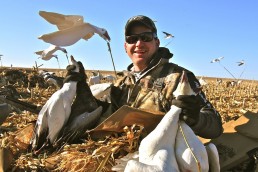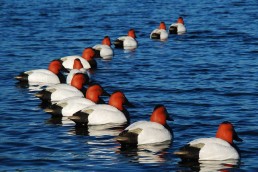E-caller, Decoy Strategies for Snow Geese
SHARE THIS POST
Passion for the Hunt
The framework for the spring conservation season for snow geese allows the use of additional tools like E-callers. And while these tools are effective, hunters continue to modify and adapt their tactics. The amount of decoy spreads that snow geese encounter up and down the Flyway is astronomical. Snow geese are hunted eight months out of the year, and the birds are conditioned and educated.
Dustin Patterson has been a fanatical spring snow goose hunter for two decades, and has followed the migration up through the U.S. and into Canada.
Patterson offers the following tips for your decoy placement and E-callers, and why they’re effective:
1. Migrating birds need “room” to make a drop in their elevation.
Spread the decoy setup deep, or a tall vs. wide fashion. Snow geese are more “vertical,” and prefer working into the decoys and often look to finish toward the top or upwind side of a spread. This is far different in comparison to Canada geese that often descend more “horizontally,” working the downwind edge of a spread. Place your blinds near the top of the spread for closer shots. Keeping the decoys loose on the upwind sides focuses or dictates where the birds will attempt to finish. Refrain from bunching up or grouping decoys close together below the blinds.
Are you enjoying this post?
You can be among the first to get the latest info on where to go, what to use and how to use it!
2. Electronic calls are necessary.
Use electronic calls because a real flock of snow geese makes a lot of noise that’s almost impossible to duplicate. E-callers are louder and more realistic, but there are mistakes many hunters make and these geese get smarter, and many have to adapt to be successful. Luckily, for hunters, E-callers keep getting more durable and easier to use. Most in the past incorporated heavy batteries, speakers and cords strung across the ground. When dealing with UTVs and mud where every piece of gear gets hauled out, these heavy and fragile pieces of equipment were a challenge. The hottest trend for today’s snow goose hunter is incorporating predator calls because these calls are lightweight and extremely portable. Predator Calls, like the Lucky Duck Revolt, run on AA batteries and are self-contained units with a digital amp. But many love the remote capabilities these have that allow the control of multiple soundtracks from one remote where the hunter can also control the volume.
3. When incorporating electronic calls, have at least one speaker or two nearby your blinds and watch your volume.
Sometimes, these should be behind the blinds and pointed straight up. And more E-callers are used 20-40 yards downwind. Today’s generation of E-callers bring obvious advantages to the table and the ability to sound like “a lot of geese” is paramount. But take caution when making some basic mistakes and experiment with volume. But don’t be afraid to drop the volume down when birds are working the spread. We find that what happens is that birds stall at 70-80 yards if the volume is too high; this just sounds loud and unnatural to the birds. We record the four soundtracks found on the new Revolt E-caller. These flock sounds were edited for maximum sound quality and crispness at higher volume levels. Besides these preloaded tracks, all Lucky Duck E-callers play off SD cards from either MP3 or WAV formats.
4. Loud, high-pitched barks and yelps can be heard from much farther away.
A flock of snow geese makes a lot of noise as they move and feed across a field. And it’s that chatter of ebbs and flows as birds reposition, making them excited. Cut across or go upwind farther with the sounds, as this element of the track is crucial for breaking down high migrating birds. The lower-pitched feeding noises and growls add additional realism and add the sound of “content” and feeding geese. What I like to do is run four tracks at the same time where the track is staggered on each E-caller to combine all these different sounds for added “realism.”
Particularly for hunters dealing with mud and other conditions in spring or other seasons where ATVs or sleds are needed to haul gear, the self-contained E-callers of today work perfectly for the discriminating snow goose hunter.
Did you enjoy this post?
You can be among the first to get the latest info on where to go, what to use and how to use it!

